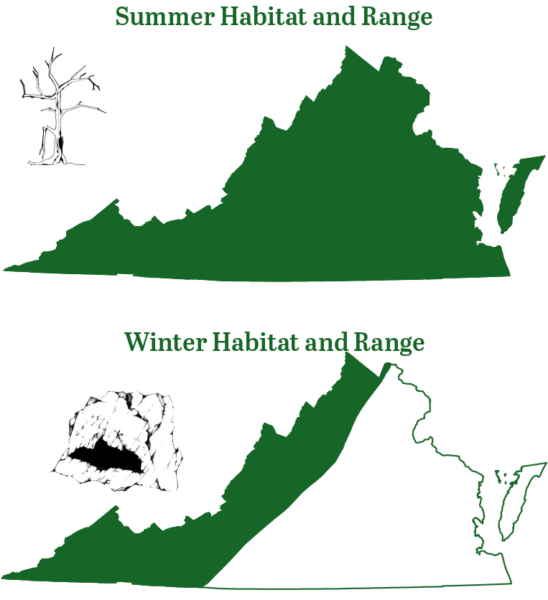Northern Long-eared Bat. © Al Hicks, New York Department of Environmental Conservation.
Northern Long-eared Bat. Illustration by Brittany Fernald.
Fact File
Scientific Name: Myotis septentrionalis
Classification: Mammal, Order Chiroptera
Conservation Status:
- Species of Greatest Conservation Need-Tier 1a on the Virginia Wildlife Action Plan
Identifying Characteristics
The northern long-eared bat is very similar in appearance to the little brown bat and several other Virginia Myotis species. The northern long-eared bat measures 3–3.5 inches in length and weighs 0.17–0.35 ounces. This species can be distinguished from other Myotis species by its dagger-shaped tragus and long ears. The ears of this bat are 0.5–0.7 inches in length and, when laid flat along the muzzle, they extend past the nose by about 0.2 inches.
Habitat
The northern-long eared bat hibernates in caves during the winter but has been found in artificial habitats such as mines and dams. These bats show a preference for tight slots and small out-of-the-way places in which to hibernate, but they may also be found in the open. They are most frequently observed hanging individually or in small groups of two or three bats crammed into a small crevice. In addition, they can be found hibernating in mixed clusters with other species such as little brown and Indiana bats.
Diet
The northern long-eared bat is unique in its feeding habit, as it snatches food from leaves, twigs, and the ground. This form of feeding is referred to as gleaning, and food items include moths, flies, beetles, caddisflies, and spiders.
Reproduction
Little is known about reproduction in this species. Mating apparently takes place in the fall, and delayed fertilization presumably results in the birth of one pup in the spring. Small maternity colonies are formed consisting of fewer than 100 females. Maternity sites have been found under exfoliating bark of trees, in barns and other buildings, and even under bridges. Males and females swarm near and in the entrances of caves in August and September.
Conservation
White-nose syndrome is the primary threat to this species. Protection of hibernacula and maternity colonies are conservation priorities.
Last updated: August 14, 2024
ShopDWR
Order your copy of A Guide to the Bats of Virginia, along with more gear, guides, and gifts!
Visit ShopDWRThe Virginia Department of Wildlife Resources Species Profile Database serves as a repository of information for Virginia’s fish and wildlife species. The database is managed and curated by the Wildlife Information and Environmental Services (WIES) program. Species profile data, distribution information, and photography is generated by the Virginia Department of Wildlife Resources, State and Federal agencies, Collection Permittees, and other trusted partners. This product is not suitable for legal, engineering, or surveying use. The Virginia Department of Wildlife Resources does not accept responsibility for any missing data, inaccuracies, or other errors which may exist. In accordance with the terms of service for this product, you agree to this disclaimer.


